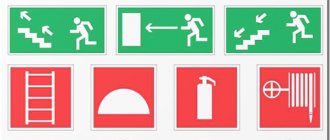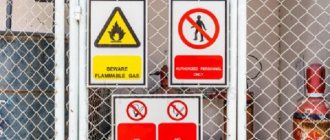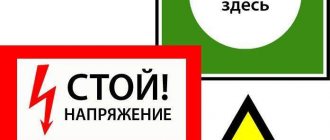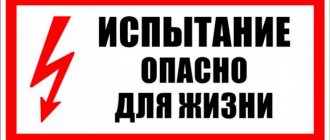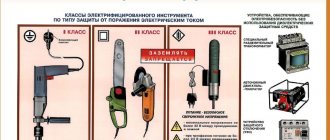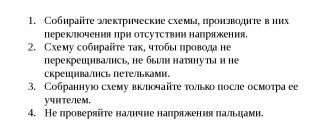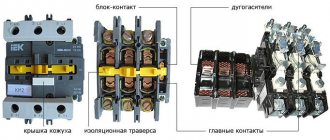Types of signs
Prohibiting
They are decorated in a red circle with a white field inside, crossed out by an inclined red stripe; in the middle, a forbidden action is graphically depicted in black.
Here are examples of prohibitory safety signs in table form:
| No smoking | Used to indicate areas that may catch fire as a result of smoking. In addition, it is established in connection with the requirements of Federal Law No. 15-FZ dated February 23, 2013 on the ban on smoking in public places (Article 12 of the law directly requires the installation of signs prohibiting smoking). Placed on doors and walls of premises, areas where there are combustible and flammable substances, or in premises, territories and objects where smoking is prohibited. | |
| No entry | Used to designate places with areas hazardous to life and health. Placed at the entrance to hazardous areas, premises, areas, etc. | |
| Pets are prohibited | Used on gates or doors of premises where animals should not be present. |
Occupational Safety and Health Warning Signs
Warning signs are an equilateral triangle with rounded corners, yellow, pointing upward, with a black border.
Here are examples of safety warning signs in table form:
| Carefully. Slippery | Used in areas and areas where there is a risk of slipping. | |
| Dangerous. Toxic substances | Used where toxic substances are stored, released or produced. | |
| Attention. Forklift | Used during unloading and loading operations. |
Mandatory safety signs
Round shape blue.
Examples of such safety signs:
| Work with safety glasses | Used in work areas where vision protection is required. |
| Work in protective clothing | It is used in those workplaces where the use of personal protective equipment is necessary. |
| Passage here | Indicates an area where passage is permitted. |
Fire safety signs
Square shape red. Here are examples of fire safety signs in table form:
| Directional arrow | Used only in conjunction with other fire signs to indicate the direction of movement to fire protection equipment. |
| Fire extinguisher | Located in areas where fire extinguishers are located. |
| Telephone for use in case of fire | It is installed in places where the telephone is located, by which you can call the fire brigade. |
Evacuation and medical and sanitary signs
Square or rectangular green.
Examples:
| Direction to the emergency exit down the stairs | Installed on landings and walls adjacent to them. |
| First aid kit | Placed on the walls and doors of rooms to indicate the location of the first aid kit. |
| Medical office | Located on the doors of medical rooms. |
Warning signs
These signs are intended to warn of possible danger. Warning signs are a yellow triangle with a black border along the outline and a symbolic image of black on the inner field.
| Colorographic image | Semantic meaning | Location (installation) and recommendations for use |
| Fire hazardous. Flammable substances | Use to draw attention to areas with flammable substances. On entrance doors, cabinet doors, containers, etc. | |
| Explosive | Use to draw attention to areas with flammable substances. On entrance doors, cabinet doors, containers, etc. | |
| Fire hazardous. Oxidizer | On room doors and cabinet doors to attract attention to the presence of an oxidizing agent. |
Information and warning labels on engineering products.
It is advisable to provide information and warnings on the machine in the form of clear symbols or pictograms. All written or oral information and warnings must be in the official language or languages of the Community as may be determined in accordance with the Treaty by the Member State in which the equipment is placed on the market or put into service and, on request, they may also be in any other language. the official language or official languages of the Community, understandable to the operating personnel.
The information required to operate the machine must be clear and understandable. It is important to ensure that service personnel are not overloaded with information.
Optical indicators or other interactive means of communication between the operator and the machine must be easy to understand and convenient.
If the safety and health of persons at risk could be compromised by a malfunction in a machine whose operation is not supervised, the machine must be equipped with an appropriate audible or optical warning device.
If the machine is equipped with warning devices, the signals must be clearly understandable and easily distinguishable. Maintenance personnel must have a means to verify that these warning devices are always operational.
The provisions of the specific Community directives on safe colors and symbols shall apply.
If risks still exist despite safety measures in the design, despite safety measures and despite additional protective measures, the necessary warning notices, including warning devices, must be provided.
At a minimum, the following information must be recognizable, clear and permanently affixed to each machine:
Company name and full address of the manufacturer and, if applicable, its authorized representative,
Car name,
CE Marking (Annex III of the Machinery Directive )
Series or type designation,
serial number, if applicable,
year of construction.
When affixing the CE mark, it is prohibited to indicate a date before or after the year of manufacture of the machine. If a machine is designed and manufactured for use in an explosive atmosphere, it must be marked accordingly.
Depending on the nature of the machine, all information that is important for safety during use must also be attached to the machine.
If, during use, a machine part must be moved by a lifting mechanism, its weight must be clearly, indelibly indicated.
Each machine must be accompanied by operating instructions in the official language or languages of the Community of the Member State in which the machine is placed on the market or put into service.
The operating instructions supplied with the machine must be the "original operating instructions" or a "translation of the original operating instructions", in which case the translation must be accompanied by the original operating instructions.
Notwithstanding the above provisions, maintenance instructions which are intended for use by specialized personnel authorized by the manufacturer or his authorized representative may only be drawn up in one Community language which is understood by such specialized personnel.
Operating instructions must be written in accordance with the following principles.
General principles for drawing up operating instructions
a) The operating instructions must be written in one or more of the official languages of the Community. Language versions for which the manufacturer or his authorized representative assumes responsibility must be marked “Original Operating Instructions.”
b) If there are no original operating instructions in the official language(s) of the country of use, the manufacturer or its authorized representative or the person introducing the machine into the relevant language area shall arrange for translation into that language(s). This translation must be marked “Translation of the original operating instructions.”
c) The contents of the operating instructions must take into account not only the intended use of the machine in question, but also any reasonably foreseeable misuse of the machine.
Instructions for machines intended for use by consumers must take into account the general level of knowledge and understanding that can reasonably be expected of such users.
Contents of the operating instructions
Where appropriate, each instruction manual shall contain the following minimum information:
- Brand name and full address of the manufacturer and its authorized representative;
- Machine designation as indicated on the machine itself, excluding the serial number;
- an EC declaration of conformity or a document that reproduces the contents of the EC declaration of conformity and contains individual information about the machine, but does not necessarily contain the serial number and signature;
- general description of the machine;
- drawings, electrical diagrams, descriptions and explanations necessary for the use, maintenance and repair of the machine, as well as for checking its correct functioning;
- a description of the intended use of the machine;
- warning messages regarding misuse of the machine, which experience has shown may occur;
- instructions for assembling, manufacturing and connecting the machine, including drawings, electrical diagrams and fixtures, as well as details of the machine frame or system on which or in which the machine is to be installed;
- installation and installation rules to reduce noise and vibration;
- instructions for commissioning and operating the machine and, if necessary, instructions for training or familiarization of operating personnel;
- information about residual risks that still remain despite construction safety measures, despite precautionary measures and despite additional protective measures;
- instructions on protective measures to be taken by the user, including, if applicable, personal protective equipment to be provided;
- the main characteristics of the tools that can be attached to the machine;
- the conditions under which the machine meets the requirements for stability during operation, during transport, during assembly, during dismantling, during failure, during testing and in the event of suspected failures;
- safety instructions for transport, handling and storage indicating the weight of the machine and its various components in case they must be transported separately on a regular basis;
- actions required in the event of an accident or malfunction; If a blockage is likely to occur, the operating instructions should indicate how to proceed to safely clear the blockage;
- a description of the setup and maintenance work performed by the user, as well as preventive maintenance measures that must be taken;
- instructions for safe installation and maintenance, including necessary protective measures;
- specifications of spare parts to be used if they affect the safety and health of operating personnel;
- information about the noise level generated by the machine:
Sound pressure values must either be actually measured on the machine in question or determined by measurement on a technically comparable machine that is representative of the planned production.
For very large machines, instead of the A-weighted sound power level, it is possible to indicate the A-weighted emission sound pressure level at certain points around the machine.
If harmonized standards are not used, the most appropriate measurement method must be used to determine the noise level. Whenever noise level values are given, the uncertainty that exists for these values must be stated. It is necessary to describe the operating conditions of the machine during measurement and the measurement method.
If the work location is not specified or cannot be specified, A-weighted sound pressure level measurements should be taken at a distance of 1 m from the surface of the machine and 1.60 m above the floor or access platform. The highest emission sound pressure level and the corresponding measuring point must be specified.
If Community specific directives contain other provisions for the measurement of sound pressure or sound power level, the provisions of those specific directives and not the corresponding provisions of this regulation (or the Machinery Directive) apply.
If a machine may emit non-ionizing radiation that could cause harm to people, especially those wearing active or inactive implantable medical devices, information must be provided regarding the radiation to which operating personnel and those at risk are exposed.
Advertising brochures describing the machine must not contradict the operating instructions regarding safety and health aspects. Advertising brochures describing machine performance must contain the same emission information as the operating instructions.
What is regulated
Labor safety signs are standardized, and the requirements for their production, their types, purpose and rules of application are established by GOST 12.4.026-2015, which came into force in March 2022.
The responsibilities of the person responsible for occupational health and safety at an enterprise, organization, or building include:
- Establish and mark dangerous places, warn possible dangerous situations with safety signs and warning markings.
- Set the appropriate symbols and, if necessary, make additional inscriptions explaining them.
- Determine the number, sizes and types of symbols, etc.
Material on the topic How to develop a regulation on the labor protection system at an enterprise For the absence of signs or their non-compliance with GOST, liability is provided under Article 5.27.1 of the Code of Administrative Offenses of the Russian Federation. The presence of fire signs is checked especially strictly (and their absence is severely punished - the fine for organizations reaches 200,000 rubles).
In essence, occupational health and safety signs are graphic images in a certain color, a certain geometric shape of symbols and explanatory inscriptions. Such images are used to warn people about immediate or possible danger, to prohibit, order or permit certain actions, as well as for information about the location of objects and means, the use of which eliminates or reduces the impact of dangerous and harmful factors.
Directional signs
Indication signs for fire protection equipment
Signs for fire protection equipment are designed to indicate the location of fire stations, fire hydrants, hydrants, fire extinguishers, fire notification points and other active fire protection equipment. They are a red square or a white square with a red border with a symbolic image of white or red on the inner field.
| Colorographic image | Semantic meaning | Location (installation) and recommendations for use |
| Directional arrow | Use only in conjunction with other fire safety signs to indicate the direction of movement to the location (placement) of fire protection equipment. | |
| 45° guide arrow | Use only in conjunction with other fire safety signs to indicate the direction of movement to the location (placement) of fire protection equipment. | |
| Fire hydrant | Where the fire hydrant kit with fire hose and barrel is located. | |
| Fire escape | Where the fire escape is located. | |
| Fire extinguisher | Where the fire extinguisher is located. | |
| Telephone for use in case of fire (including direct contact telephone with the fire brigade) | In places where a telephone is located where you can call the fire department. | |
| Location of multiple fire protection equipment | In places where several fire protection means are simultaneously located (placed). | |
| Fire water source | In areas where there is a fire pond or pier for fire trucks. | |
| Fire dry pipe riser | In the locations of the fire dry pipe riser. | |
| Fire hydrant | At the locations of underground fire hydrants. The sign must have numbers indicating the distance from the sign to the hydrant in meters. | |
| Button for turning on fire automatics installations (systems) | In places where fire alarm, fire extinguishing and (or) smoke protection systems are manually started. At places (points) where a fire alarm signal is given. | |
| Fire alarm sounder | In the locations of the sounder or together with sign F 10 “Button for turning on fire automatics installations (systems)” |
Signs for evacuation purposes
Indicative signs for evacuation purposes are used to indicate the direction of evacuation routes and emergency exits. They are a green square or rectangle with a symbolic image or white inscription on the inner field.
The placement of safety signs on the gates and entrance doors of premises indicates that their coverage area covers the entire territory or given premises.
| Colorographic image | Semantic meaning | Location (installation) and recommendations for use |
| Exit here (left side) | Above the doors (or on the doors) of emergency exits opening on the left side. On the walls of the premises along with a directional arrow to indicate the direction of movement to the emergency exit. | |
| Exit here (right side) | Above the doors (or on the doors) of emergency exits opening on the right side. On the walls of the premises along with a directional arrow to indicate the direction of movement to the emergency exit. | |
| Directional arrow | Use only in conjunction with other evacuation signs to indicate the direction of travel. | |
| 45° guide arrow | Use only in conjunction with other evacuation signs to indicate the direction of travel. | |
| Direction to the emergency exit right/left | On the walls of premises to indicate the direction of movement to the emergency exit. | |
| Direction to the emergency exit right/left up | On the walls of premises to indicate the direction of movement to the emergency exit along an inclined plane. | |
| Direction to the emergency exit right/left down | On the walls of premises to indicate the direction of movement to the emergency exit along an inclined plane. | |
| Emergency exit door indicator (right/left) | Above the doors of emergency exits. | |
| Direction to emergency exit straight ahead | Above passages, openings, in large areas. Placed on the upper level or suspended from the ceiling. | |
| Direction to the emergency exit down the stairs | On landings and walls adjacent to the flight of stairs. | |
| Direction to the emergency exit up the stairs | On landings and walls adjacent to the flight of stairs. | |
| Open here to access | On doors, walls of rooms and in other places where, to gain access to a room or exit, it is necessary to open a certain structure, for example, break a glass panel, etc. | |
| Open with a movement away from you/toward you | On room doors to indicate the direction of door opening. | |
| Slide to open | On room doors to indicate actions for opening sliding doors. | |
| Collection point (place) | On doors, walls of premises and in other places to designate pre-designated gathering points (places) for people in the event of a fire, accident or other emergency. | |
| Exit sign | Above the emergency exit doors or as part of combined safety signs to indicate the direction of movement to the emergency exit. | |
| Emergency exit sign | Above the emergency exit doors. |
Mandatory signs
Mandatory signs are intended to issue commands for the mandatory execution of certain actions. They are a blue circle with a symbolic image of white on the inner field.
| Colorographic image | Semantic meaning | Location (installation) and recommendations for use |
| Work in personal respiratory protection equipment | In workplaces and areas where respiratory protection is required. | |
| Turn off power | At workplaces and equipment where disconnection from the power supply is required when setting up or stopping electrical equipment and in other cases. | |
| Smoking here | Used to designate smoking areas in industrial facilities. |
